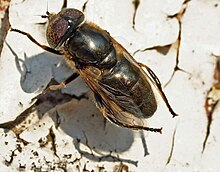| Eristalinus sepulchralis | |
|---|---|

| |
| male | |

| |
| female | |
| Scientific classification | |
| Domain: | Eukaryota |
| Kingdom: | Animalia |
| Phylum: | Arthropoda |
| Class: | Insecta |
| Order: | Diptera |
| Family: | Syrphidae |
| Genus: | Eristalinus |
| Species: | E. sepulchralis |
| Binomial name | |
| Eristalinus sepulchralis (Linnaeus, 1758) | |
| Synonyms | |
Eristalinus sepulchralis is a European species of hoverfly. The species are brownish-white from a close up, and look like a wasp. From a distance though, they are yellowish-black coloured, and look like a bumble bee. The species can be found throughout Europe in the Baltic states, North Europe, Central, Southern and Western Europe and across the Palaearctic to Kamchatka, Japan, China and India. Finland, Great Britain, Hungary, Ireland, Norway, and the Netherlands.
Technical Description
External images For terms see Morphology of Diptera
Wing length 6 ·5–8 mm. Eyes patterned with conspicuous black spots and hairy all over in both sexes. Tergites black with green or other reflections. Tergites 2 and 3 with a dull spot. Male eyes well separated on frons. Thoracic dorsum with five grey stripes. The male genitalia and larva are figured by Pérez-Bañón et al. (2003). The larva is figured by Hartley (1961)
Biology
Habitat is wetland, fen, river and pond margins. Anthropophilic and occurring where stock is pastured, along polluted ditches and in the vicinity of slurry pits. Flowers visited include white umbellifers, Achillea millefolium, Allium, Armeria maritima, Bellis perennis, Bidens cernua, Caltha, Cochlearia danica, Crataegus, Euphorbia, Galium, Leontodon, Origanum vulgare, Potentilla erecta, Ranunculus, Rosa, Rubus fruticosus, Salix, Senecio jacobaea, Solidago virgaurea, Sorbus aucuparia, Taraxacum, Tussilago, Valeriana dioica.
The flight period is mid-April to September (March to October in southern Europe). The larvae are associated with rotting vegetation in a ponds and small water bodies rich in nutrients.
References
- Close up description
- From a distance
- Ernst, Torp (1984). De Danske svirrefluer (Diptera: Syrphidae). Fauna Boger. pp. 300pp. ISBN 9788788738001.
- Stubbs, Alan E.; Falk, Steven J. (1983). British Hoverflies: An Illustrated Identification Guide. British Entomological and Natural History Society. pp. 253, xvpp.
- Distribution
- Peck, L.V. (1988) Syrphidae. In: Soos, A. & Papp, L. (eds.) Catalogue of Palaearctic Diptera, 8: 11-230. Akad.Kiado, Budapest.
- Pérez-Bañón, C., Rojo, S., Ståhls, G. & Marcos-García, Mª A. (2003) Taxonomy of European Eristalinus (Diptera: Syrphidae) based on larval morphology and molecular data. Eur.J.Entomol., 100: 417-428.
- Hartley, J.C. (1961) A taxonomic account of the larvae of some British Syrphidae. Proc. Zool. Soc. Lond. 136:505-573.
- Van Veen, M. (2004) Hoverflies of Northwest Europe: identification keys to the Syrphidae. 256pp. KNNV Publishing, Utrecht. addendum
- Van der Goot,V.S. (1981) De zweefvliegen van Noordwest - Europa en Europees Rusland, in het bijzonder van de Benelux. KNNV, Uitgave no.32: 275pp. Amsterdam.
- Bei-Bienko, G.Y. & Steyskal, G.C. (1988) Keys to the Insects of the European Part of the USSR, Volume V: Diptera and Siphonaptera, Part I. Amerind Publishing Co., New Delhi. ISBN 81-205-0080-6.
- Coe, R.L. (1953) Diptera: Syrphidae. Handbks.ident.Br.insects, 10(1): 1-98. R.ent.Soc.London. pdf Archived 2018-10-04 at the Wayback Machine
- Speight, M.C.D. (2011). "Species accounts of European Syrphidae (Diptera)" (PDF). Syrph the Net, the Database of European Syrphidae. 65: 285pp.
- de Buck, N. (1990) Bloembezoek en bestuivingsecologie van Zweefvliegen (Diptera, Syrphidae) in het bijzonder voor België. Doc.Trav. IRSNB, no.60, 1-167.
| Taxon identifiers | |
|---|---|
| Eristalinus sepulchralis | |